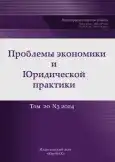Модели правового регулирования государственно-религиозных отношений в России в исторической ретроспективе
- Авторы: Зудов Ю.В.1
-
Учреждения:
- Московский государственный юридический университет имени О. Е. Кутафина (МГЮА)
- Выпуск: Том 20, № 3 (2024)
- Страницы: 14-19
- Раздел: Теоретико-исторические правовые науки
- URL: https://journals.eco-vector.com/2541-8025/article/view/635616
- EDN: https://elibrary.ru/PUBISR
- ID: 635616
Цитировать
Полный текст
Аннотация
Цель исследования. В статье рассматриваются различные модели правового регулирования государственно-религиозных отношений, действовавшие в России от IX века до сегодняшнего дня. В период с IX по XVII век в России существовала своеобразная модель симфонии власти и религии, где государство и церковь были тесно связаны, но в определенной степени сохраняли самостоятельность. Церковь играла важную роль в политической жизни страны, а государство поддерживало и защищало церковь. В XVIII веке после проведения секуляризации церковной собственности государство постепенно отошло от модели симфонии. В XIX веке Русская православная церковь получила привилегированное положение в Российской империи, но оставалась под контролем государства. Выводы. Автор отмечает, что на протяжении всей истории России эти отношения были различны и подвержены изменениям в зависимости от политических, социальных и культурных факторов. В XX веке Советская власть провозгласила секуляризм и отделение церкви от государства. Церковь была подвергнута гонениям, и ее влияние на общество значительно сократилось. После распада СССР отношения между государством и церковью постепенно улучшались. В 1997 году был принят закон, который обеспечил свободу вероисповедания и равенство всех религий перед законом. В настоящее время отношения между государством и церковью имеют партнерский характер, при этом Русская православная церковь продолжает оказывать значительное влияние на политическую жизнь страны.
Полный текст
Об авторах
Юрий Валерьевич Зудов
Московский государственный юридический университет имени О. Е. Кутафина (МГЮА)
Автор, ответственный за переписку.
Email: yury.zudov@mail.ru
SPIN-код: 8255-8906
кандидат исторических наук, доцент кафедры истории государства и права
Россия, г. МоскваСписок литературы
- Багаева К. А. Государственно-религиозное взаимодействие в современном российском обществе // Вестник Бурятского государственного университета. Философия. 2016. № 3. С. 83–80.
- Петюкова О. Н. Модели государственно-конфессиональных отношений: зарубежный опыт правового регулирования // Вестник Финансовой академии. 2010. № 3 (57). С. 57–61.
- Алексеев С. В. Государственно-церковные отношения в России: от традиции к глобальной информатизации // PolitBook. 2019. № 2. С. 97–108.
- Moran G. Los retos estructurales de la Iglesia católica en la sociedad del siglo XXI. Reflexiones sobre los modelos eclesiales y la evolución de la Tradición, el Magisterio y el Derecho de la Iglesia católica // Stato, Chiese e pluralismo confessionale Rivista telematica. 2016. № 27. P. 40.
- Григоренко А. Ю. Основные типы и модели государственно-церковных отношений в современном мире (ХХ-ХХІ века) // Вестник РХГА. 2015. №2. С. 140–144.
- Мирошникова Е. М. Основные тренды отношения государств Европейского союза к религии // Современная Европа. 2020. №3. С. 196–206.
- Мирошникова Е. М. Кооперационная модель государственно-церковных отношений: опыт и проблемы. М.: Ин-т Европы РАН, 2007. 181 с.
- Осавелюк А. М. Государство и Церковь. М.: Проспект, 2019. 432 с.
- Кравченко Е. В. Становление государственно-конфессиональных отношений в древнерусском государстве // Философия права. 2016. №1. С 29–33.
- Дювернуа Н. Л. Источники права и суд в Древней России: опыты по истории гражданского права. СПб.: Университетская типография, 2004. 413 с.
- Бауэр Е. А. Теория «Москва—третий Рим» в трактовке И. А. Кириллова // Magistra Vitae. 2007. №18. С. 144–148.
- Ефимовских В. Л. Священство и царство: к вопросу о модели государственно-церковных отношений в Московский период // Вестник Пермского университета. Юридические науки. 2013. №1. С. 38–46.
- Тихомиров М. Н. Соборное уложение 1649 года. М.: Изд-во Моск. ун-та, 1961. 444 с.
- Успенский Б.А. Царь и патриарх: харизма власти в России (Византийская модель и ее русское осмысление). М.: Языки рус. культуры, 1998. 680 с.
- Тимиргазиева А.И. Государственно-религиозные отношения в советский период // Дискуссия. 2014. №2 (43). С. 120–126.
Дополнительные файлы








